cp_badlands: TF2's de_dust2
the rich history of a competitive TF2 staple
It would be hard to name a map with more popularity in the Team Fortress 2 competitive community than Badlands. Since its release in 2008, the map quickly became a staple, forming the backdrop to some of the most exciting competitive matches in history. Badlands’ dominance in the competitive scene stretches nearly 8 years, surpassed only by the perennial Granary in longevity. Badlands has been reworked to come in multiple flavors, with arena_badlands and koth_badlands released in 2008 and 2011 respectively. Interestingly, while the cp_badlands is easily the most famous variation, it is a remake of a Team Fortress Classic map, ctf_badlands. Early on its TF2 development, it was designed as a Capture-the-Flag map as well but this idea was quickly replaced with the modern capture point design.
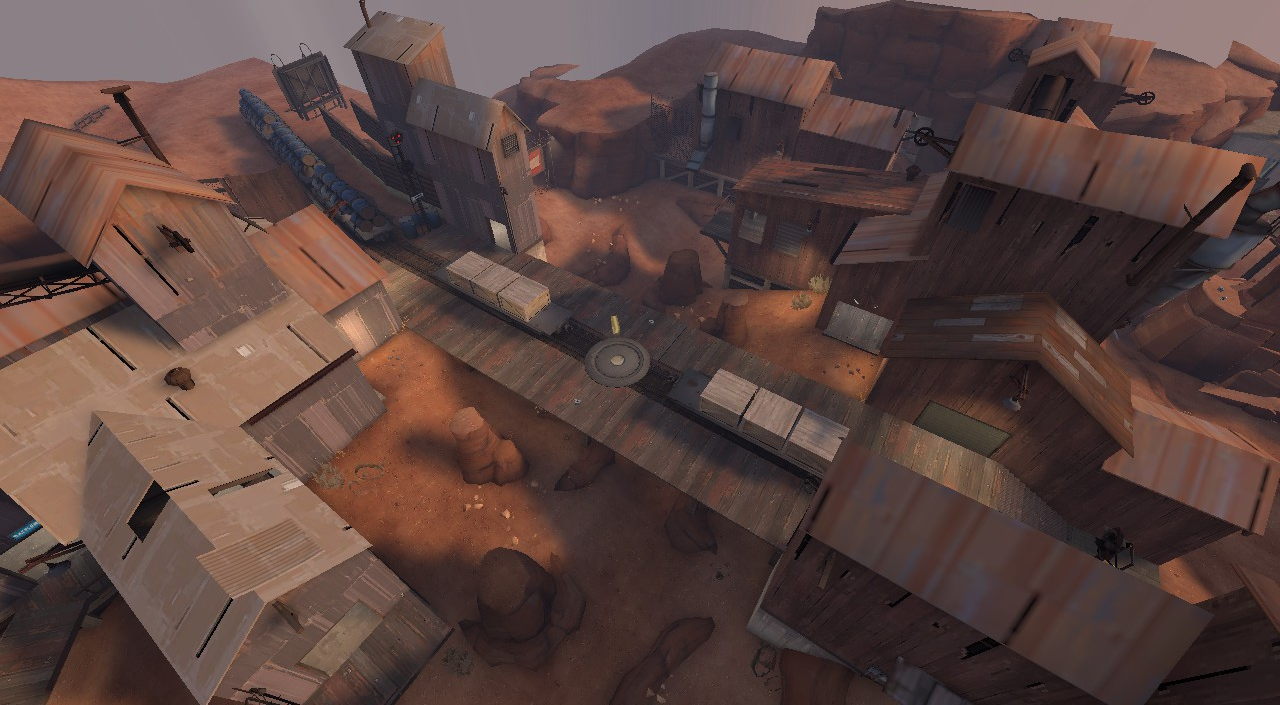 aerial view of Badlands’ middle point
aerial view of Badlands’ middle point
Why is Badlands so popular? Its mid spreads out fighting across multiple layers of verticality and forces teams to commit to the fight instead of sitting back and spamming. Its second point is a spire, allowing for flashy displays of technical skill. The last point creates interaction between the defending and aggressing teams without unduly punishing either and the capture time of the point is fast but vulnerable, forcing teams to continually evaluate the risks and rewards of sacking straight for the point or taking the high ground for an extended fight. Pushing out of last offers complications as well, requiring a team move quickly and with enough synergy to both take the spire and clear out possible backcappers hiding along the way. Badlands presents the competitive player with a series of options at each stage of the game, creating a fluid and varied game experience. In this respect Badlands serves as the ultimate standard for how competitive TF2 should be played.
In the rest of this article I intend to follow the shifts in Badlands’ meta from the early stages of ESEA to the present day.
Season 4 and Before: The Wild West
In many ways, playstyles on Badlands throughout ESEA play have shifted alongside more general ideas about how to play 6v6 as a whole. Season 4 is a perfect example of this. During this time, flanks were largely left unchecked and empty, overheals were barely on the register of most medics (in comparison to modern play), and midfights consisted of both teams rolling out through house, taking their train, and fighting until one team was almost wiped. Holding second, if it happened in a proper, orderly fashion, would usually involve putting the combo on gray bridge and even trash, spamming rockets at the incoming team, then backing out. Last holds weren’t too out of the ordinary, but even then it was common to see the roamer holding with the combo on the right side. The roamer in general played a much more combo-centric playstyle—without the Gunboats it wasn’t possible for a roamer to quickly reposition on the flanks without suffering intense health damage, and so often they played close to the medic and periodically wandered off. When preparing for a last push medics and combos would often hold in lower lobby, although a number of top teams held in top lobby as modern teams do now. Teams attacking last would almost always pop uber on their pocket through the main entrance as other team members rushed the point, and the pocket would jump up to the high ground to fight.
Positioning, strategies, and even class roles as a whole were considered much looser. It was very much an “anything goes” type atmosphere, with the mentality being that if it worked, it worked. As a result, Season 4 playoffs on Badlands saw one side run a heavy to mid and the other run a pyro to mid. “Pocket” strats like this were fairly common at the time—one favored strat was running pyro with backburner through valley, up to shithouse, and into the enemy’s train, where the medic was prone to hold.
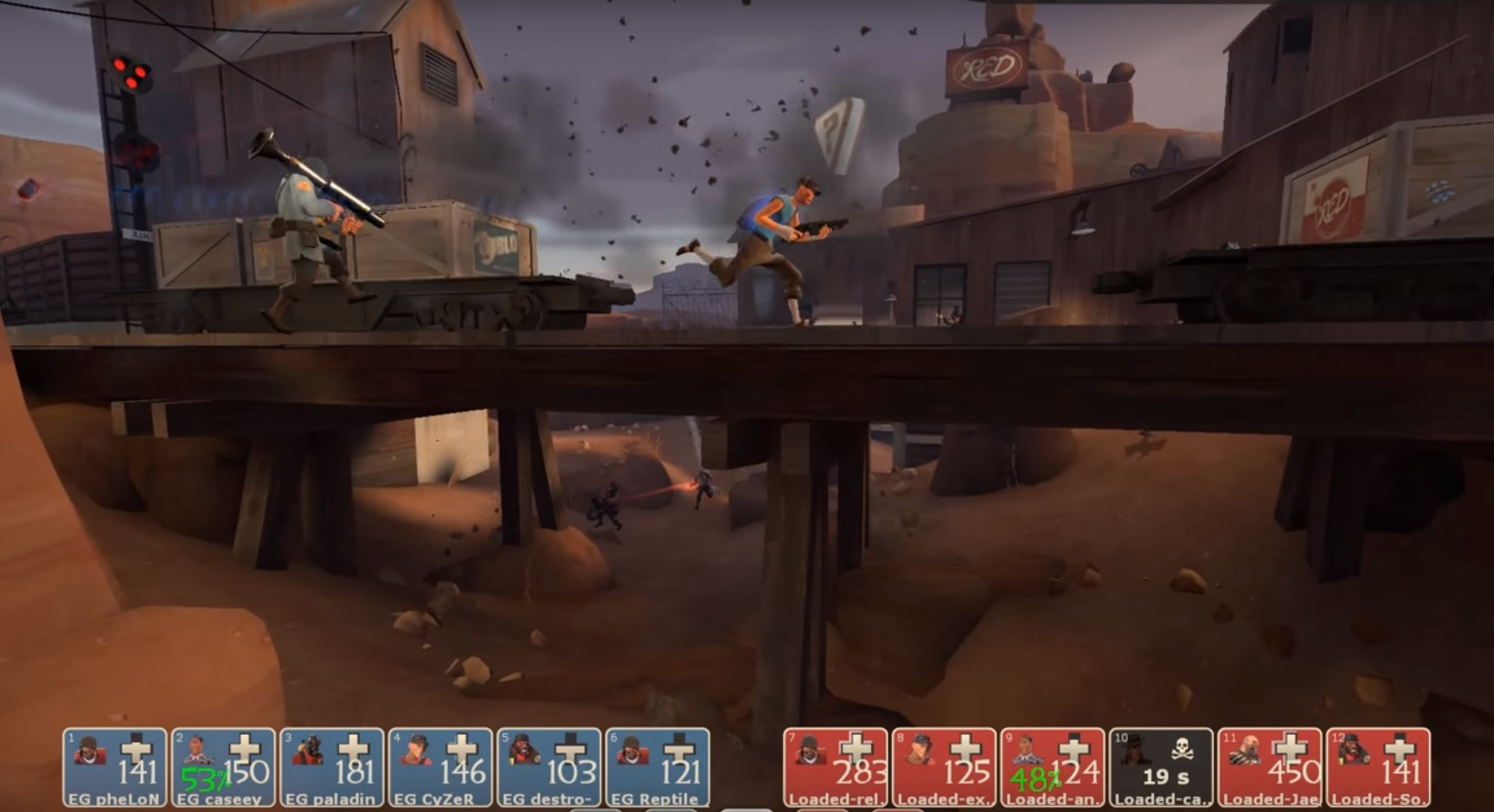 Season 4 grand finals between Evil Geniuses and Loaded sees heavy, sniper, and pyro run to mid
Season 4 grand finals between Evil Geniuses and Loaded sees heavy, sniper, and pyro run to mid
This was the era of dominance by compLexity (known as Loaded up until Season 5) and Badlands was a perfect showcase of this. At the time, soldiers were often relied on as the impact players and hard carries of the team. coL had a tremendous combo in relic on pocket and PYYYOUR on medic, a combo that could take any other in the league head to head and win. Not only that, but coL had an ace up their sleeve. With loose, unguarded flanks, non-overhealed soldiers, and soldiers rarely watching lower left on last pushes, carnage, coL’s star scout, could play in a manner best fitting his skillset: running straight into enemies and meatshotting them before they could return fire. In a period where scouts as a whole were less powerful due to overall lower skill and fewer overheals, carnage could rip holes in combos and singlehandedly win his team pushes. The carnage/enigma scout pairing is considered one of the greatest of all time, and when backed by the PYYYOUR/Relic combo with Jaeger and SoLIDSnaKE on roamer and demo, coL’s synergy and raw skill made them look unbeatable.
Season 5: Beginnings of Change
Season 5 saw wholesale changes to TF2’s competitive landscape. Scouts as a whole began to rise to the top of the game, competing with soldiers on a more equal footing due to generally better aim and movement. coL’s secret sauce wasn’t quite as secret anymore. cyzer had long been considered a carnage-slayer, but now other scouts could be as well. Teams such as Muscle Milk and Moolians (MmM) had the synergy needed to prevent carnage from walking in for free, and MmM scout Stamjally was one of the best scouts of the time. This, paired with their demo ducky, who liked to jump aggressively and had the pill aim to back it up, led to a team with less importance placed on the soldiers, in many ways foreshadowing the eventual changes of top level playing styles.
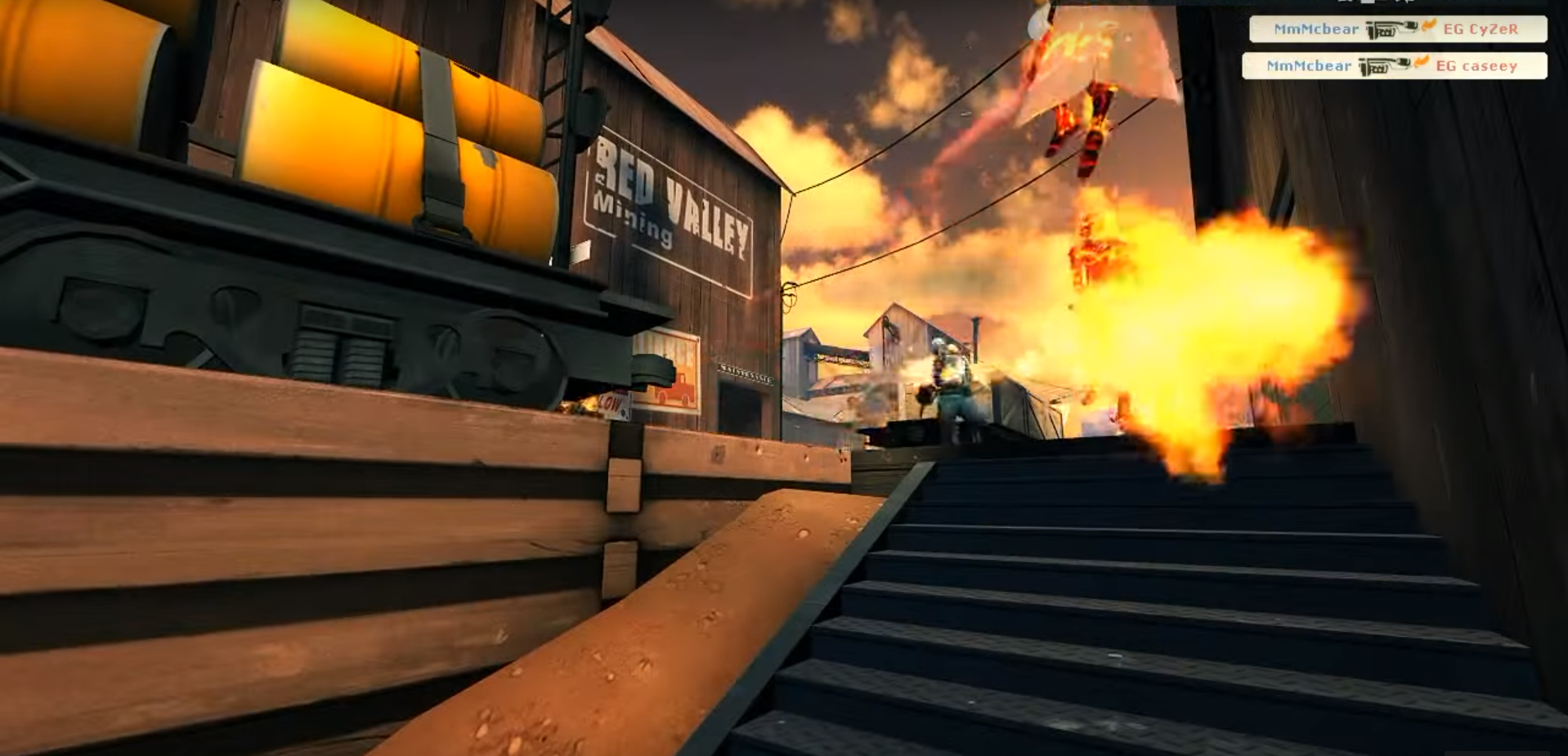 MmM roamer cbear on pyro flanking through shithouse against EG on mid (image taken from one of TF2’s most phenomenal frag videos, Muscle Milk and Moolians)
MmM roamer cbear on pyro flanking through shithouse against EG on mid (image taken from one of TF2’s most phenomenal frag videos, Muscle Milk and Moolians)
Season 5 saw other changes for the top teams as well. For the first time, ESEA TF2 Invite finals would be played on LAN in Dallas. While many of the top players had played LANs for other leagues or in other games (Quake being an early breeding grounds for high level TF2 talent), the change in dynamic certainly threw wrenches in the gears of well-oiled TF2 killing machines, both in terms of strategy and player attendance. MmM, despite the potential shown by beating coL on Badlands, were not in attendance and were replaced by Blight, who had finished the season 6-10 in Invite. Pandemic tied the top of the standings with coL in the regular season, but were forced to play without their main demo, kermit, at LAN; instead using the untested and largely unknown shade as demo. enigma was unable to attend, with animeman as his replacement. Finally, DM powerhouse EG (with players such as cyzer, sycknesS, and reptile), had davis fill in the wide shoes of demoman and team captain destro. With three of the LAN teams forced to rely on replacements, the stage was set for an unpredictable finals.
Blight, though faced with the first seed EG, came out of the gates hard, shutting down EG on Badlands in the first half and riding the momentum to a series win. coL, facing off against Pandemic, showed that though their roster may have been changed, carnage didn’t need his scout partner enigma to work his magic. In the first match on Badlands, carnage racked up more kills than both Pandemic scouts combined, carrying his team to a 5-1 victory and a series victory as well. Badlands wasn’t played again at LAN until game 3 of the finals between plucky underdogs Blight and perpetual champions coL.
In this game, Blight asserted their dominance on midfights, often taking the capture through aggressive rollouts that prevented coL from getting into position. Blight’s flank, with roamer Seagull and scout oPlaiD, was also able to largely contain carnage as well as get aggressive attacks onto the coL combo. However, Blight was often unable to convert their victories in DM fights on mid into successful uber v. uber pushes on second due to coL’s legendary synergy and uber management by PYYYOUR, relying instead of scrappy play and backcaps to pick up round wins.
Although Blight could win mid, coL could roll uber fights back to Blight’s last, bottling them up and waiting for carnage to showcase his sniping prowess from main. coL played a grinding game, using their strategic mastery of uber fights, including combo flanks into resupply, cutting off Blight’s combo from retreating. SoLIDSnaKE in particular utilized non-traditional unlocks, using the Scottish Resistance to clear stickies off the last point in attempts to aggressively sack the point. coL did fail many last pushes, often taking the upper left ledge with their uber before losing due to DM fights on the ground and around the point, but were able to prevent Blight from pushing back out to the second point, allowing carnage as much time as he needed to get his impact picks on sniper. The game was very close, ending tied at 4-4 in regulation, but coL ultimately won in overtime to seal the championship.
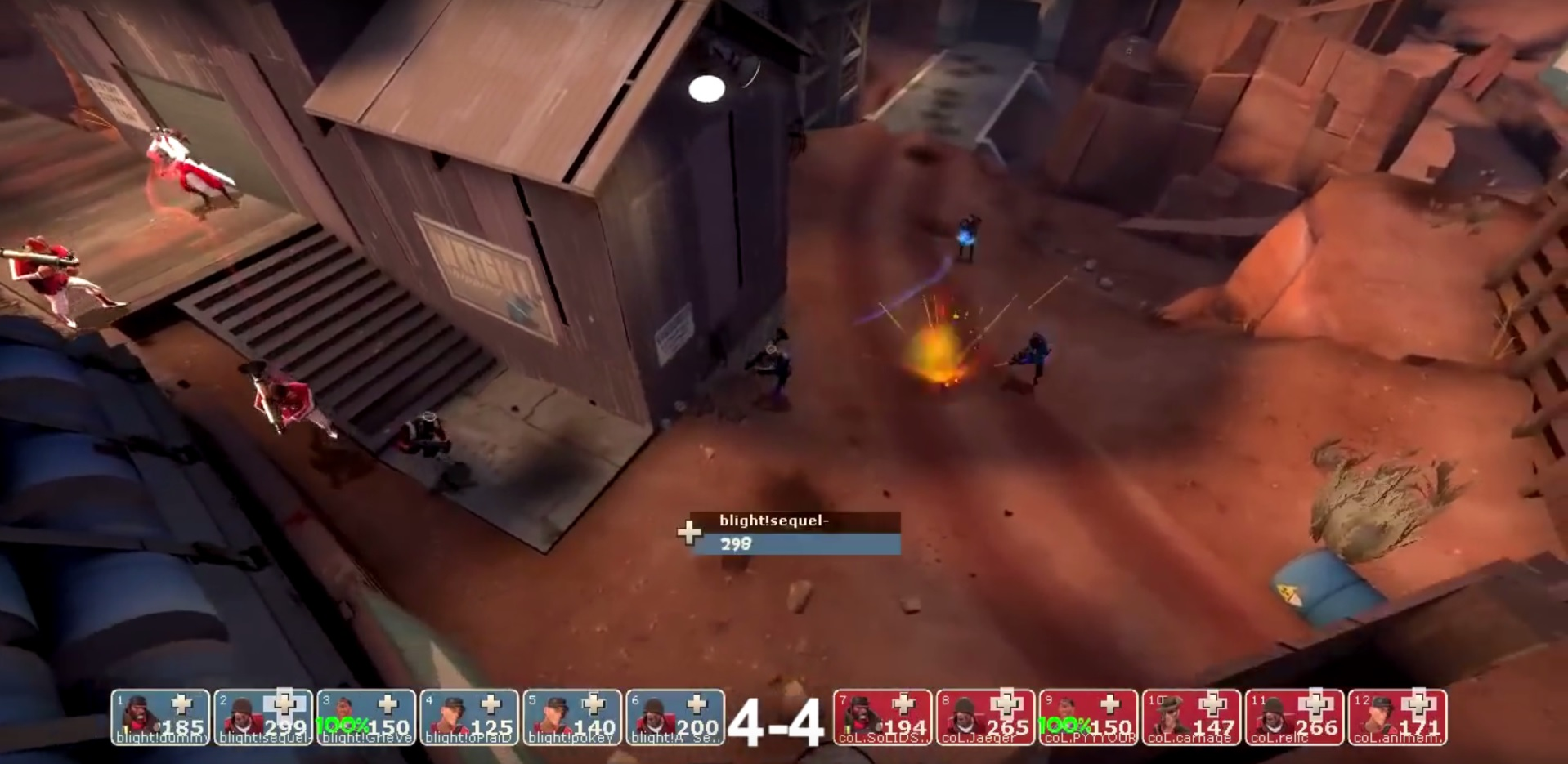 coL preparing to push choke with even ubers against Blight in the Season 5 grand finals
coL preparing to push choke with even ubers against Blight in the Season 5 grand finals
In retrospect, Season 5 served as a turning point for Invite TF2 as a whole and Badlands in particular. While coL won LAN in convincing fashion, they were shown to be vulnerable. carnage, while still a devastating force, could not roam through the flank at will due to a general increase in other Invite scouts’ skill levels, better distribution of overheals, and tighter cohesion between roamers and scouts on the flank. Unlocks saw more use (though not used to their full potential quite yet) while offclasses (excepting sniper) saw less, and the stage was set for Season 6.
Seasons 6-10: Unlocks Abused
While the Equalizer (then a combination of the Escape Plan and Equalizer’s benefits) was used in Season 5, it wasn’t until the next season that teams began to realize its potential for rollouts. Blight’s Seagull had showcased its potential for damage in Season 5, going on multi-kill sprees, but now teams were ready to adapt completely new strategies centered around the weapon. While previous seasons would see teams rollout through house, take their respective trains, and duke it out on mid, wider usage of the Equalizer allowed for a more dynamic approach. Now combos could rollout through valley, which made obsolete the classic “backburner pyro through shithouse” or the less-frequent “heavy through valley up to hoodoo” strategies due to early vision on slopes and enemy valley, and allowed for punishing teams that attempted to sit on their own train via devastating bombs from valley to the enemy train.
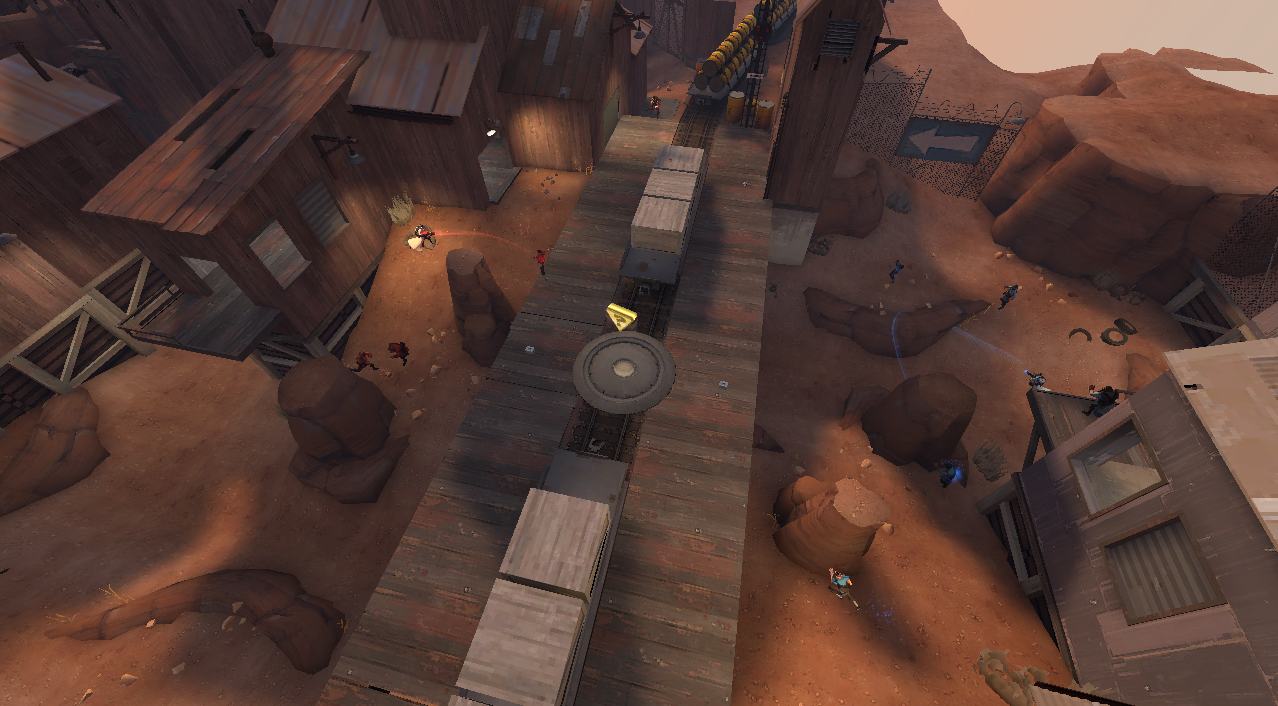 x6 and Blight both rollout to mid through valley at Season 8 LAN
x6 and Blight both rollout to mid through valley at Season 8 LAN
This period also saw the adoption of the Gunboats, now considered a staple of competitive play. The Gunboats allowed a much more aggressive roamer style, creating a larger differentiation between the pocket and roamer role. While the roamer running shotgun could be devastating on the flanks, it allowed him less mobility and he was often forced to play close to the combo in order to receive the heals needed to do his job. With Gunboats, a more fluid and dynamic roamer style became possible—no longer would roamer have to serve as static firepower. Instead, the roamer could jump around behind enemy lines, serve as a constant distraction, and wait for the right moment to bomb into the combo and unload his rockets. harbleu was a prominent early adopter of this style and this play led to the success of Blight.own, which would many seasons later become known as the Classic Mixup dynasty. At the time however, there was much criticism of this style of play, leading many prominent players to refer to the style (and harbleu in particular) as “jumping around uselessly like a loon.” Similar to the advent of Equalizer rollouts, it took a while for roamers to fully understand the use of this new unlock and practice the fluid jumps necessary to reach its potential.
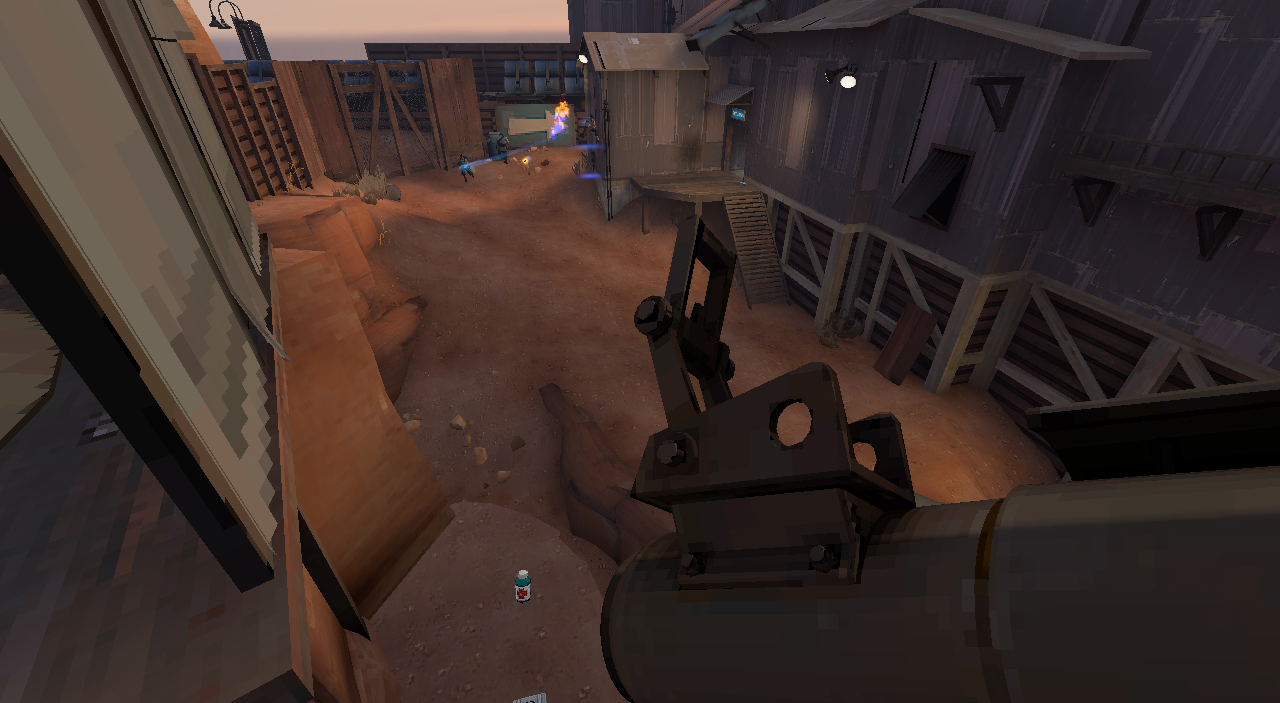 Blight’s harbleu using Gunboats to aggressively flank coL and threaten them from their spire in the Season 6 regular season
Blight’s harbleu using Gunboats to aggressively flank coL and threaten them from their spire in the Season 6 regular season
When it was perfected, however, it led to vast shifts in the TF2 meta as a whole. While previously teams often had to win uber v. uber fights through the sheer firepower of the pocket, now teams were able to more consistently force their opponent to uber in bad situations and then uber their own team back in for more reliable pushes. This in turn led to teams placing more importance on scouts and their abilities to guard flanks and deny bombers. While the Gunboats were a powerful tool in harassing the enemy combo, removing the shotgun also made roamers significantly more vulnerable to scouts. During this same period, the MGE training mod was birthed and scouts with amazing aim and movement like yz50 rose to prominence. With more importance placed on scouts, it was only natural that the need for overhealed flanks began to be understood at a deeper level. A scout like yz50 with 185 health may not have had the same level of impact as carnage in the early years, but it was certainly nothing to sneeze at, either by the enemy combo or their flank.
Teams could now statically hold the midpoint after a round win, with the combo spamming choke to prevent bombers and scouts rotating back to the combo for overheals before trying to create space on the flank for their roamers to initiate a fight. The waiting game became much more effective, as roamers could fail their bombs but still return to the fight with decent health after respawn.
CheckSix Gaming (x6) became the most legendary team of this era due to their innovative use of unlocks and their “blob” style in pushes. Starring players such as TLR, Dave_AC, and harbleu, their high intensity and raw aggression saw them take Invite’s first perfect season in Season 8. On Badlands in particular they only lost two rounds in both their regular season matches combined, and lost only four rounds in two matches on LAN. x6 demo Kalkin played a heal-heavy role, relying on harbleu’s notorious survivability to allow TLR and Dave_AC to push aggressively and make space for the rest of the team. Kalkin also popularized a number of other Badlands’ specific strategies, including a sticky trap on spire that now bears his name in callouts and hiding above the point on last. This latter point proved a tough nut for many teams to crack, and served as a foreshadowing of Australian demo termo’s brilliant hidden defense of Badlands’ last at i52.
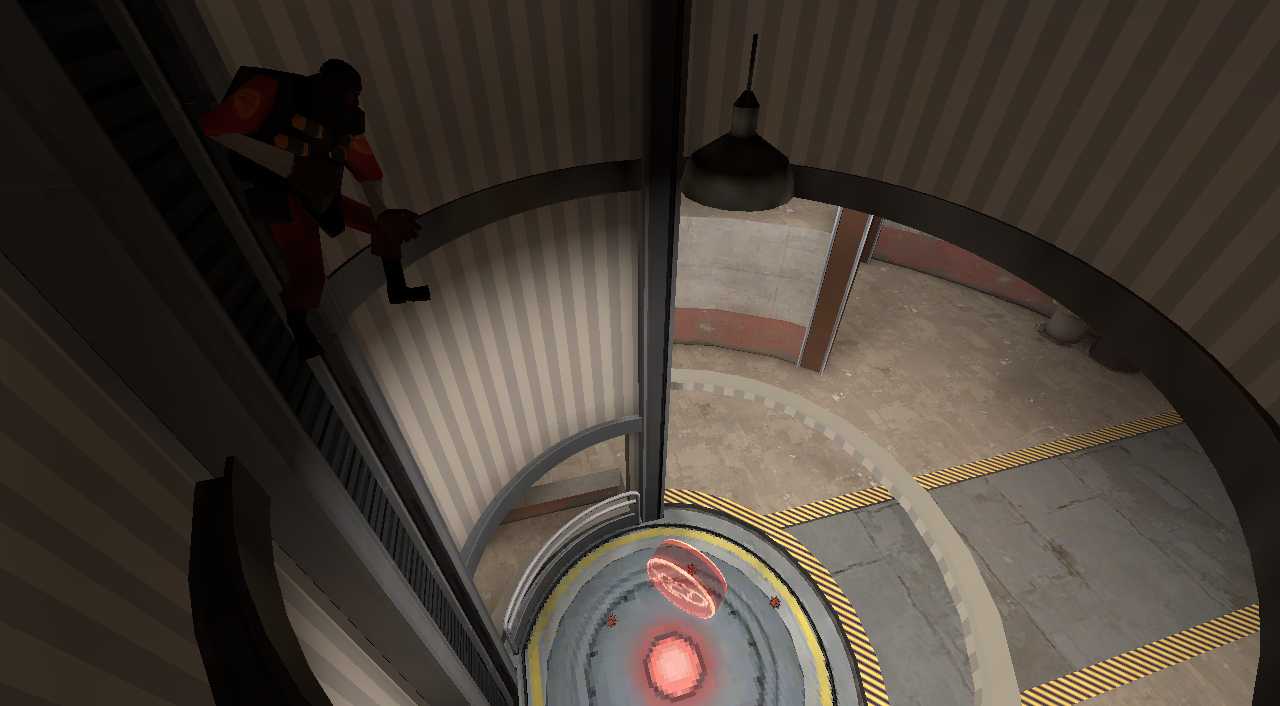 x6 Kalkin hiding as he prepares to fend off Blight’s last push at Season 8 LAN
x6 Kalkin hiding as he prepares to fend off Blight’s last push at Season 8 LAN
x6 would routinely push on the slightest of uber advantages, or even no advantages at all. In one memorable push against Blight at Season 8 LAN, x6 push into middle with a three man disadvantage and managed to take the point with near flawless uber management from medic harbleu. x6 was also prone to running Kritzkrieg on Badlands at the drop of a hat, and perfected a brutal last push where x6 scouts would rush the point as Kalkin was ubered in up top, forcing the enemy to drop down to defend the point while Kalkin rained stickies down on top of them.
These new approaches culminated in what is considered one of the greatest 6s games of all time, the Upper Bracket Finals at Season 10 LAN between Quantic Gaming (qXg) and Classic Mixup (mix^). Though the old coL was long dead at this point, mix^ medic harbleu carried on its strategic legacy through gutsy, aggressive pushes such as flanks through diagonal bridge while pushing the second point and calling attacks on the slightest margins of uber advantage. enigma, also playing for mix^, showed the extreme strength of pyro on last holds, shutting down qXg ubers into the top left. However, neither were enough for qXg’s solid play focused around their demo b4nny, and qXg ended up taking the match.
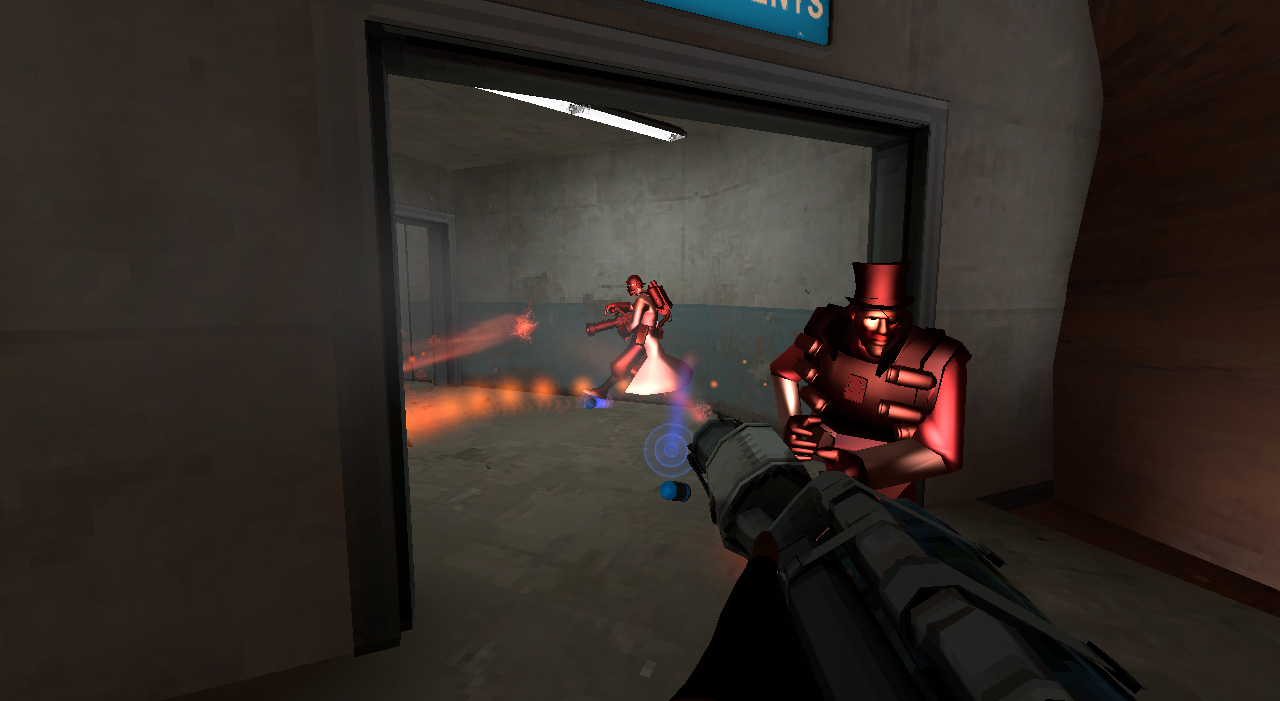 enigma defending mix^ last against qXg in game 3 of the Season 10 grand finals
enigma defending mix^ last against qXg in game 3 of the Season 10 grand finals
Seasons 11-15: Out With the Old
Season 11 began with the emergence of a superteam that looked capable of disrupting the by now eternal LAN battles between mix^ and eMg/qXg/LG. PYYYOUR, formerly of coL and The Experiment, created a team designed around new and unorthodox strategies: Mihaly’s Flow. With harbleu and ww, the two soldiers, running double Gunboats, Flow was predicated on scout shrugger’s ability to completely dodge damage while protecting the medic, a method known to MMO fans as “evade tanking.” With Ruwin and soup filling out the roles of scout and demo, the team was filled to the brim with raw DM alongside strategic brilliance.
srsly br0 was in many ways an interesting comparison to Flow, once again relying on the double Gunboats soldiers with demoman dummy pocketing. This setup allowed br0 to capitalize on their tremendous DM potential, resulting in a team that looked like something out of WWE’s Ruthless Aggression era.
While Flow put more importance on strategy than br0, who often utilized their DM to brute force pushes, the double Gunboats approaches for both teams proved tremendously successful on Badlands. Their soldiers were able to create tremendous space, disrupt enemy teams, and stay alive for quite some time, allowing scouts like yz50 and Ruwin enough room to work their magic. Both these teams proved their mettle on Badlands during the regular season, with four convincing wins and only dropping four rounds on the map between the two.
Disappointing performances by Flow at LAN eventually culminated with the creation of two new teams with diametrically opposed playstyles: a merger of mix^ and Flow combining the aggression of both teams, and a much more grinding, slow roster with b4nny known as High Rollers Gaming (HRG). HRG would win a fight and put a chokehold on the enemy team, preventing them from pushing in while utilizing roamer Taggerung for repeated bombs until they could successfully find a forced uber. HRG’s approach proved to be superior on Badlands, with them finding dominant LAN wins on Badlands against their rivals in successive seasons by preventing any room for star scout Ruwin of mix^ to maneuver.
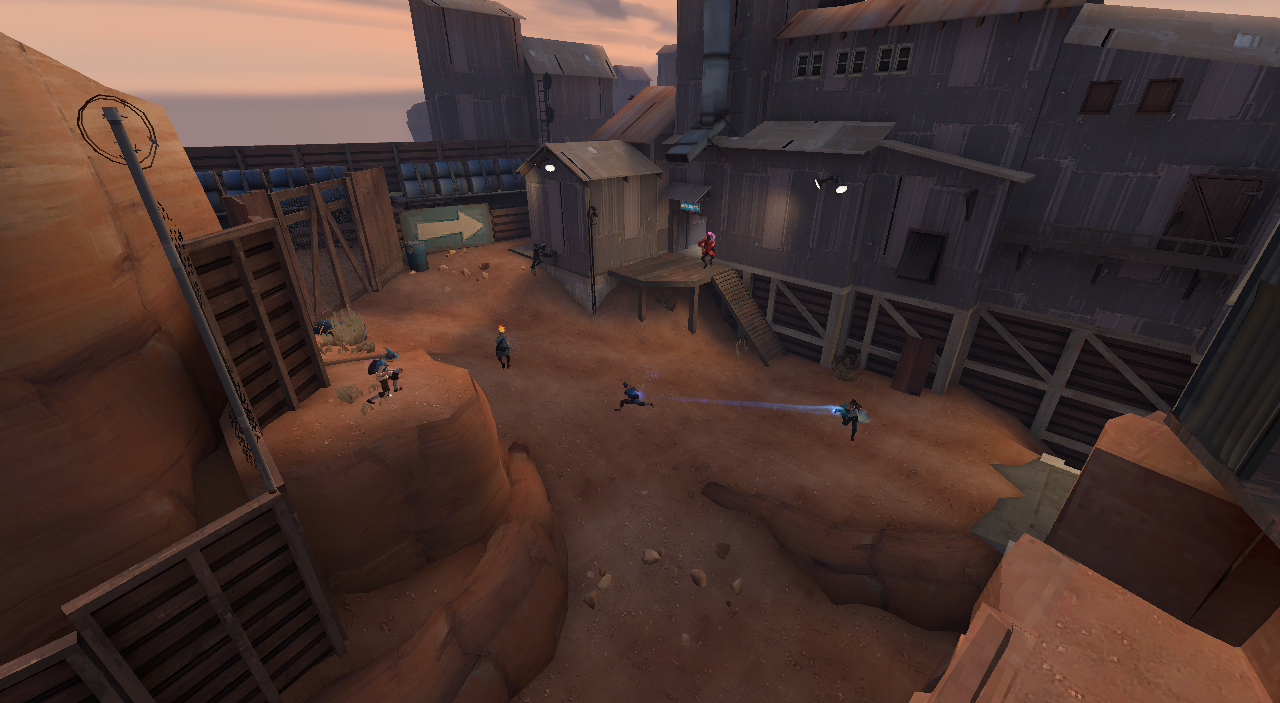 HRG Taggerung bombing mix^ medic smaka in a Season 14 Badlands regular season match
HRG Taggerung bombing mix^ medic smaka in a Season 14 Badlands regular season match
Seasons 16-20: In With the New
b4nny consolidated his dominance in Season 16 by creating a new superteam, froyotech. FROYO combined the synergy of HRG with ruthless aggression to become the most dominant team in the history of ESEA Invite. From the formation of FROYO to the present season, FROYO has won all eight regular season games on Badlands while dropping a total of 7 rounds on the map. FROYO’s closest rivals during this period (handing them their only finals loss on Badlands) were Ascent, a team composed of heavily experienced Invite players led by TheFragile, an Invite veteran since Season 5. Ascent’s style on Badlands pushed back the clock by a few years, with pocket rando running shotgun (one of the last high Invite pockets choosing to do so regularly), taking heavy heals, and taking the entirety of Ascent’s ubers to unleash his 4 rockets and 6 shotgun shots. Ascent’s power classes were as consistent as they were heal-hungry, laying the foundations for scout alfa to try his hand at a dynamic offclassing style. While this play was enough for them to win games on Badlands against most teams and even take three rounds off of FROYO on the map, it was unable to shut down the scout pair of b4nny and clockwork on such a scout-friendly map.
With the increasingly fast-paced meta, teams that lost both their medic and the midfight were often unable to put up an effective defense on second, leaving them with the uncomfortable position of having to hold last against an uber push with no uber of their own. As Badlands’ last is close quarters with little room to kite ubers, this was essentially a death sentence. While engineers on last have never been rare, these seasons saw a rise in their usage. A level 3 sentry would be set up on the right side, immediately outside spawn. This sentry would force the attacking team to waste a portion of their uber to destroy it, allowing the defending medic time to kite and get the uber in time to hold the point.
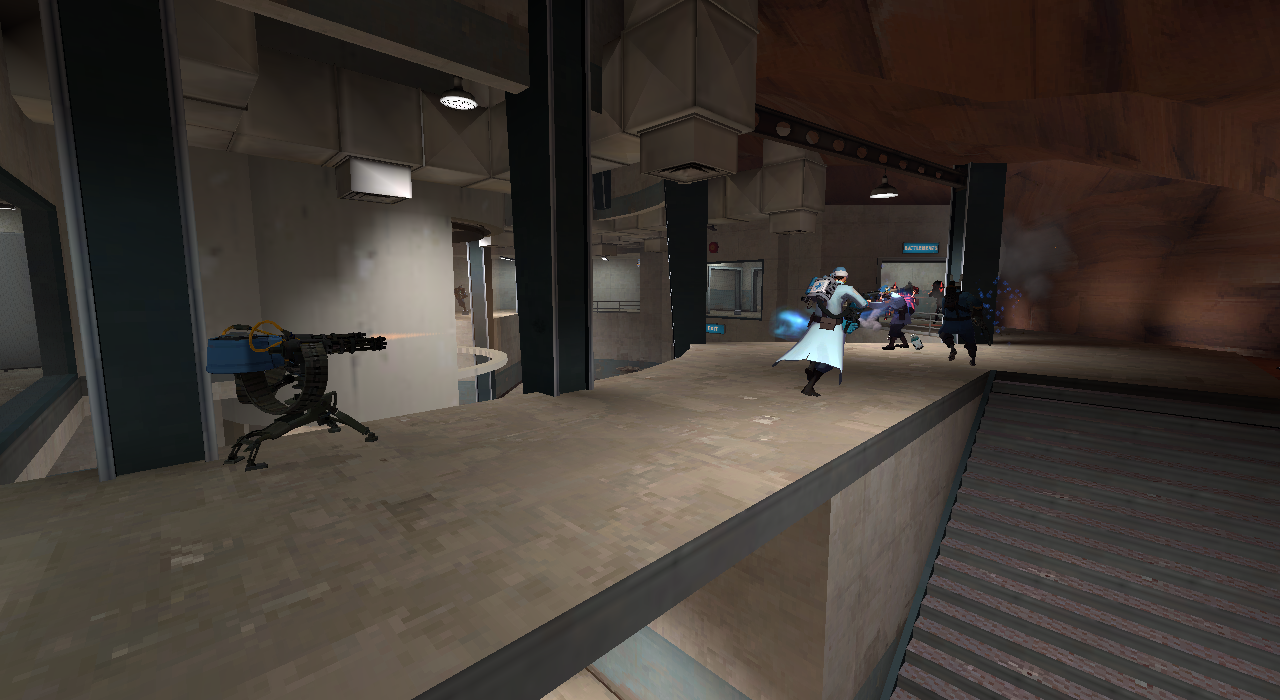 Ascent defending last with engineer and pyro against a Mad Men uber in Season 18
Ascent defending last with engineer and pyro against a Mad Men uber in Season 18
Season 19 saw Ascent replace alfa with shrugger on scout, and this new roster proved to be quite dominant, finished the season in 1st place with a 15-1 record. More importantly, Ascent managed to defeat froyotech in the second round of playoffs with a grueling 5-4 victory on Badlands. As such, Ascent became the only team since Classic Mixup in Season 16 to defeat FROYO on the map, although it must be noted that FROYO medic shade was forced to sit out part of the second half due to unstable internet, giving the Ascent victory a small asterisk in the history books.
Season 20 saw Ascent making further changes that complemented their Badlands’ playstyle particularly well, replacing Decimate with the new-to-Invite yomps and replacing TheFragile with phorofor, originally a Highlander medic who had climbed the 6v6 ranks to become one of Invite’s top medics. The roster changes proved effective during the regular season, with Ascent winning 5-0 on the map against mid-Invite teams EVL and bl4nk’s Meat Market (a team that had taken a game off of Ascent in seasons prior). The league as a whole had begun to shift due to the increased usage of Gunboats on pocket, and midfight wins often rolled rapidly to last pushes without a second defense. The yomps and shrugger pair proved devastating in this new meta, racking up kills, taking down the enemy medic almost at will, and perhaps most importantly evading damage. This last aspect meant overheals could be distributed significantly faster, leading to a team ready to compete in the fast-paced environment of modern TF2.
Ascent met their rivals FROYO on Badlands in the upper bracket of playoffs, and were eager to prove their previous Badlands victory had been no fluke. Ascent performed admirably, with their scout pair and Bdonski’s Loose Cannon able to contain FROYO clockwork’s relentless aggression, but they were unable to close out the match and lost 5-3. Last points in particular proved a difficult nut for the Ascent roster to crack, and Ascent was often only able to win rounds through backcaps and risky plays through the lower right. Despite the loss, the match proved that FROYO was beatable on Badlands and showed that Ascent had made vast strides on the map.
Season 21 and Beyond: Where to Now?
The end of Season 20 and beginning of Season 21 sees Invite in perhaps the most competitive playoff race since Season 8. FROYO’s (somewhat less than complete) reign of dominance finally ended, although b4nny revived the team with a new roster full of eager up-and-comers. Ascent was originally seen to be Invite’s new “final boss,” but in perhaps the most surprising off-season in TF2 history, EVL Gaming hit the ground running and won their first 6 games, including victories against TSU and FROYO. EVL scouts slemnish and arekk are turning heads with league dominating performances, showing they have the potential to go toe-to-toe with clockwork on a map like Badlands and come out not too far behind, if not ahead.
In response to these lightning fast pushes with aggressive scouts, some teams have turned to a forward hold first innovated by the EU team Team Dignitas back in 2010. Instead of conceding lobby, the defending team opts to hold upper lobby. The demo sticks up the shutters, the pocket spams spire from balcony, the roamer watches dropdown, and the scouts watch the lower left and main. Such a defense allows the defending medic to buff his entire team and forces the attacking team to either climb spire (and lose their uber advantage) or pop through the shutter doors in a disadvantageous position. The former allows the defending team to retreat back to last and prepare for a much more equal uber v. uber push, while the latter allows the defending team to kite the uber in relative safety back to last, or, if the stars are aligned, to stuff the uber by juggling the enemy team as they attempt to cross through the shutter doors. A completely stuffed uber puts the defending team in a perfect position to repush second, as they know there’s no one behind for a backcap and are already halfway to the spire.
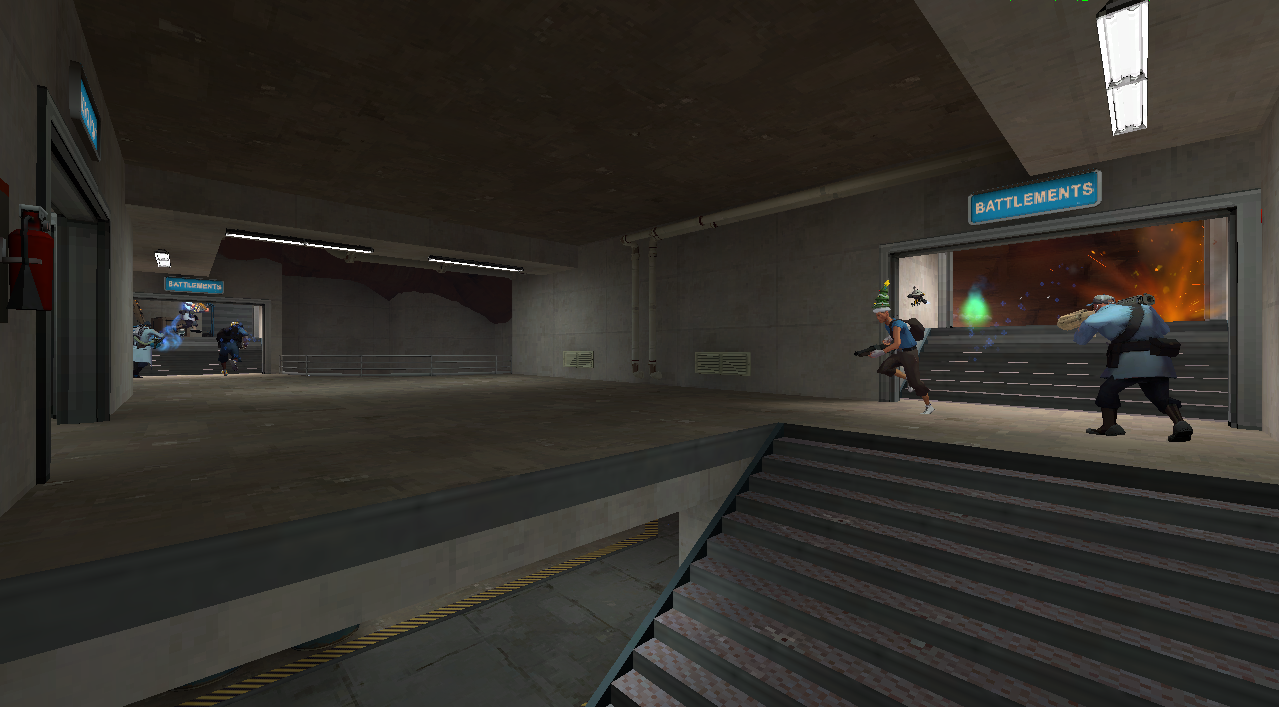 The Bugs prepare a forward hold against EVL in the regular season of Season 21
The Bugs prepare a forward hold against EVL in the regular season of Season 21
Conclusion
In many respects, the changing meta of Badlands can be directly tied to how teams were able to utilize the skills of their scouts. While early teams saw slugfests between ubered pockets as the route to victory, as teams began to refine their approaches and scouts ground their DM more and more alternative playstyles opened up. It’s important to note that while the meta as a whole has become much more aggressive and focused on pushing off of slim advantages, the more aggressive playstyles have not necessarily proven strictly superior on Badlands, as evidenced by matches between mix^ and HRG. The most successful teams were those able to incorporate both styles of play: the grinding and methodical pushes of HRG, and the double Gunboats soldier aggression initiated by Flow. It was often said that “when b4nny learns how to push, his team will become unbeatable” and with HRG/froyotech’s streak of 4 consecutive undefeated regular seasons, this prophecy appeared to be fulfilled. In fact, the last time b4nny’s team has lost a regular season match on Badlands was May 2012.
It’d be tempting to close with a message about how the new era of Badlands play is beginning, with EVL Gaming positioned as the next coL, Flow, or FROYO, but Badlands has proven resistant to such tea leaf readings. The forward hold actually first arrived in ESEA back during Season 9, but quickly lost steam when once teams began ubering scouts straight through the hold and into last. The hold remained a strong option in theory, but it took years for teams to properly understand how to execute it and return it to the meta. Badlands’ meta exists in a constant state of flux, and shows TF2 enthusiasts that we can’t necessarily predict the future but we’ll always enjoy the ride.
Many thanks to mustardoverlord for his insight on Seasons 4-8, Beater for his demo pack, and jomo for proofreading.